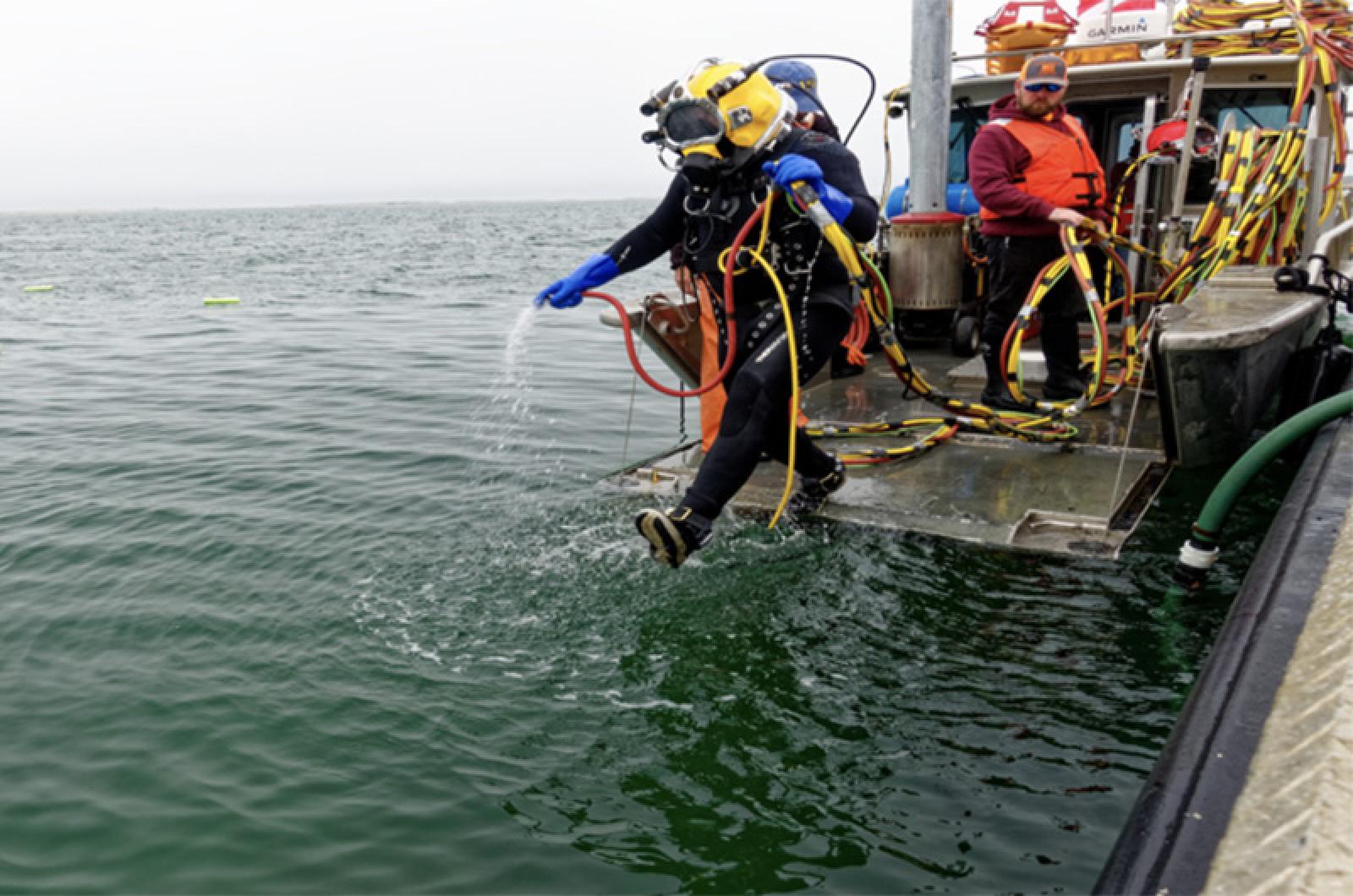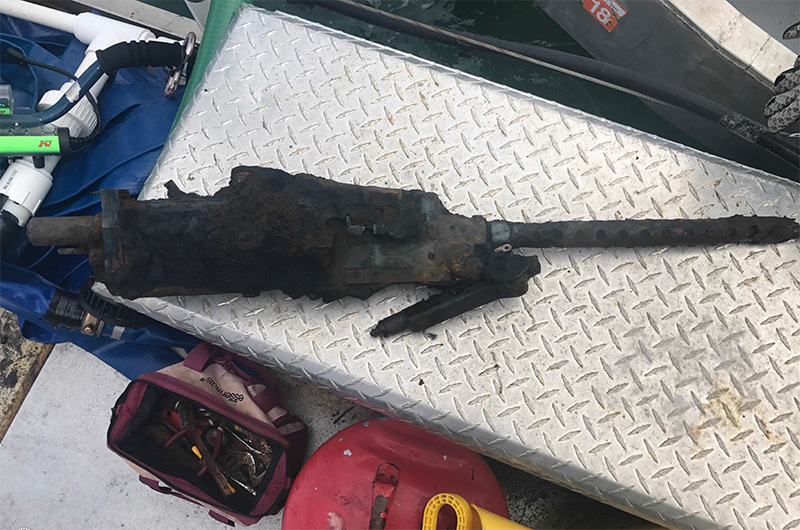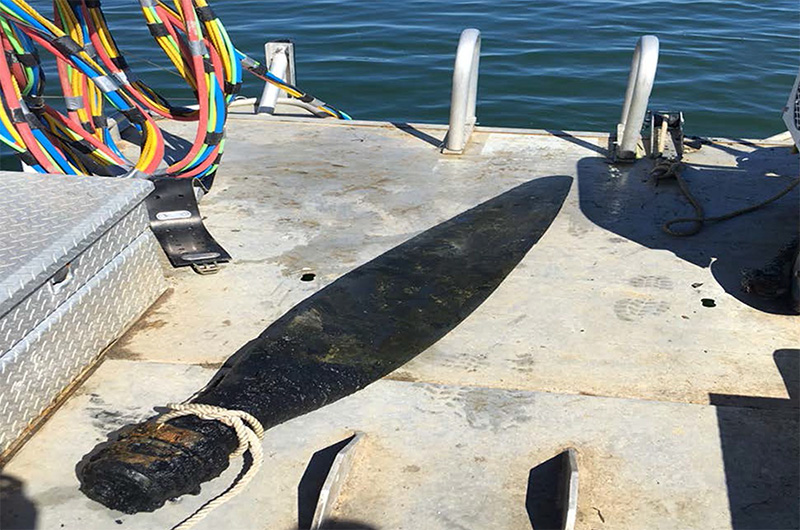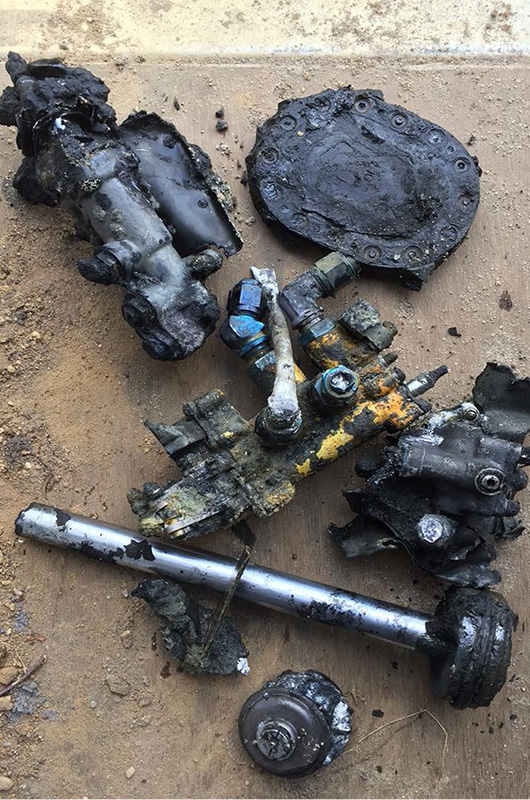An old Navy sailor poem has a final stanza that goes roughly like this: “I’m a Helldiver pilot/and I’ll never be 20 years old.”
Three weeks after the U.S. Army Corps of Engineers confirmed that it had retrieved 1,300 pieces of a Curtiss SB2C Helldiver from the bottom of Cape Pogue Pond, positive identification remains unclear on the human remains found with the aircraft.
But interviews with naval historians and archaeologists, and documents released following a Freedom of Information Act request by the Gazette, have shed more light on the little-known history of a World War II bombing plane and the young men who trained in perilous conditions to fly it.
For more than 50 of those young men around the Vineyard — and thousands more around the country — that enlistment also came at the expense of their lives.
“It was a very dangerous business, the training side of it,” said Hill Goodspeed, a historian at the National Naval Aviation Museum in Pensacola, Fla. “There were a number of fatalities that occurred in training even before people faced enemy fire.”
The Army Corps final archival documentation and analysis report released this week cites multiple sources showing that at around 10 a.m on Feb. 19, 1946, pilot ensign Cecil Richards and aviation radioman second class William Robert Garrett took off in a Curtiss SB2C-4E Helldiver from the Quonset Naval Air Station in Rhode Island for a practice dive-bombing run over Little Neck, a remote area off Chappaquiddick. They crashed in the frigid waters of Cape Pogue Pond.
Ensign Richards and Radioman Garrett had not yet reached their 21st birthdays.
Sources cited in the Corps report include an account in the Gazette, death records from North Kingston, R.I., Naval Accident Records in Norfolk, Va., a Cape Cod Standard Times story from Feb. 22, 1946 and Navy records for Bombing Squadron VB-18 History.
“Therefore, this aircraft may be a Curtiss SB2C-4E Helldiver that went down February 19, 1946 at 10:48 a.m., killing both the pilot and the radioman,” the report concludes.
A full inventory list released separately at the request of the Gazette details nearly a dozen personal items that were recovered with the thousands of pieces of the plane, including a wheat penny, a hinge bracket for the pilot’s goggles, several pieces of uniform leather, a watch band or helmet strap, and a nearly complete boot or overshoe. The personal items also included the components of life bags and pieces of rescue equipment, eerie reminders of the crash.
“The last person who touched this may have been an 18-year-old kid who packed this life vest in there,” Mr. Goodspeed said. “It makes you think about who was involved in this aircraft and how many Americans are no longer with us.”
Like some eight million other young men their age, Ensign Richards and Radioman Garrett enlisted with the United States military to defend their country during World War II. Only 60,000 of those enlistees — less than one per cent — would go on to become naval aviators. Ensign Richards was one of them.
“It was a very select group, so they felt they were a pretty special breed of individual,” Mr. Goodspeed said. “And it was a challenge to fly. There was no pressurized cabin. There was a lot of open cockpit flying. They were loud. I haven’t spoken to any World War II pilot who didn’t have a hearing issue. But for most of those aviators, and certainly all of the World War II veterans I have talked to, it was very much a defining part of their life. You had that feeling of being one with the sky.”
By 1943, two years into American involvement in the war, the larger Curtiss Helldiver had replaced the SBD Dauntless as the Navy’s frontline dive or “scalp” bomber, making its first run against the Japanese in the Battle of Rabaul. But what the Helldiver had gained in power and bulk over the Dauntless it had lost in maneuverability and handling. Navy pilots immediately came up with derogatory sobriquets for the cumbersome SB2C. The men who didn’t swear called it the Beast. Everyone else called it the [SOB] Second Class.
“It had some issues that arose in its development that delayed production,” Mr. Goodspeed said. “They tried to introduce a bunch of complicated systems for the time, particularly the hydraulics. And some of those issues plagued it throughout its career.”
On carrier landings, the ultimate trial for any naval pilot, the SB2C’s tail would often break free from the rest of the plane because of the force of its hydraulic system. Despite the problems, the SB2C would go on to equip almost every battle of the successful American campaign in the Pacific near the end of the war. It struck the Japanese army in Okinawa, Iwo Jima and the Battle of the Philippines, attacking land targets like hangars in advance of a mission, or zeroing in on zigzagging ships with a dive-bombing raid. During the war it also served as the primary training vessel for the young men who undertook those missions, providing them with between 200 and 300 hours of flight time before they ever saw combat. Many of the pilots were teenagers, stationed at Quonset or the Martha’s Vineyard Naval Air Station.
“There was a very intense ground school where you had to understand and learn how to navigate,” Mr. Goodspeed said. “There was no GPS back then. You had to learn how to use the plotting board. You had to master radio and Morse Code. You had to understand the engines and how they functioned, the principles of flight, aerodynamics, and these effects of climatological conditions on how you flew. And beyond all of that, you had to learn how to be a naval officer, because once you stopped flying, you started commanding people.”
Not everyone survived. While their training attempted to mimic the intensity and exhilaration of an open-canopy dive bomb, it unintentionally often mimicked the peril of one. According to the Corps archival report, more than 88 Helldivers crashed in training near Rhode Island alone. Mr. Goodspeed said the Navy has excavated dozens of SB2Cs from training missions in Lake Michigan as well. Seven of the planes have been fully restored, with examples in Texas, Thailand and Florida.
“It’s like a time capsule,” the naval historian said. “These are the real thing.”
But unlike those crashes, he said this is the first one he has ever heard of being excavated in the United States in which a fatality occurred.
“That adds a real sacred dimension to it,” Mr. Goodspeed said. “Normally the Navy’s policy is to leave the wrecks in situ as they are considered a veritable gravesite. But in this case it was the Army Corps munitions removal operation that found them, and they just happened upon them. It gives you an opportunity to illuminate for posterity the background of an individual who otherwise would have been anonymous. It enables you to humanize World War II.”
According to Robert Neyland, head of the Navy’s underwater archaeology branch that oversees these types of removals, the plane would not have been excavated if it had not been for the threat of munitions.
“Our purpose would have been institute preservation, leaving the aircraft there undisturbed,” Mr. Neyland said. “But they had a job to do in clearing this beach area of munitions, and they were doing it magnetically. You can’t get all the ordnance unless you remove the magnetic signature of the aircraft.”
The plane was the first unanticipated discovery for the Corps during the multi-year, multimillion-dollar munitions removal project at Cape Pogue. The second discovery followed quickly when the team of expert scuba divers sifted through material they believed to be human remains. The specimens were sent to the Boston medical examiner’s office where they were examined by a forensic anthropologist.
“The examiner confirmed that materials are human in origin, and consistent with relatively modern remains,” said Jake Wark, a spokesman for the state executive office of public safety and security who spoke with the examiners. “Decades, rather than centuries most likely.” According to Mr. Wark, the forensic analysis team could make the determination from dental specimens found at the site. “We observed dental work consistent with relatively modern techniques,” Mr. Wark said. He said the medical examiner’s office is in contact with Naval History and Heritage Command office to try to match the remains with available records.
“The impression I get is that an identification of this nature can take awhile,” Mr. Wark said.
After the war ended, the Truman administration issued a scathing report that investigated the SB2C’s production, spelling the end for Curtiss as the faster and more reliable propeller-driven AD Skyraider replaced it in the skies.
“The Helldiver sort of faded into history,” Mr. Goodspeed said.
For the SB2C excavated this summer from the Cape Pogue sea floor after 73 years, a final chapter in history — positive identification of the pilots — still awaits.







Comments (3)
Comments
Comment policy »